|
Updated May 20, 2021 $250 - $350 USD. That's what it takes to have one of these beauties for your own nowadays (2020). For those of us who couldn't afford to own a pro-level camera back when the F3 & F4 were current, now is a golden opportunity to obtain a little slice of photographic history that is as usable as ever. If you have ever picked up one after holding a consumer-level body, there is simply no comparison (Yeah, they are that solid & heavy! Especially the F4! :-)). Even with F3 values rising again (and at a faster rate than the F4's), it still comes down to the attributes most important to you, the individual photographer, when making a choice between the two (if you can't have both, that is ;-)). It is the objective of this article to clearly delineate the differences between the F3 and F4 that could influence your decision-making process. So here we go... What Are Your Priorities? (Besides Aperture) Eight years separated the introductions of the F3 (1980) and the F4 (1988). In that interval, there were some tremendous changes in 35mm SLR technology. The introduction of practical AF (Auto Focus) systems is probably the most notable, but advances were also made in shutter design, metering, flash capability and control, miniaturization, and internalization of previously external add-ons for Nikon's professional line. We will try and consider these in order of the greatest difference between the two cameras. Auto Focus - The short answer: F4 More in-depth: One cannot expect modern-day auto focus performance out of a nearly 30 year-old camera, but the F4 can hold its own with its single, central AF sensor if its limitations are respected (i.e. subject tracking for fast-moving subjects is definitely not its strong point and neither is low light). And it can use almost any AF-Nikkor lens ever made, excluding the newest "E" and AF-P types. Incidentally, there was an F3AF model released in 1983, really as a working prototype (using a more primitive version of the phase-detection AF of the F4). It featured a special AF Finder with only 92% coverage as opposed to the regular F3's 100%. It was released with 2 AF Nikkor lenses: an 80mm f/2.8 and a 200mm f/3.5 ED-IF (extra-low dispersion glass w/ internal focusing). Interestingly, these lenses had the focusing motors built-in (presaging the later AF-S lenses) rather than the motor-in-body configuration of the F4. F3AFs are more of a collectible and are priced accordingly, averaging from $550 - $650 USD with the 80mm f/2.8. You can fit them with the other manual focus finders and they will work just fine, but are not as much of a bargain as a manual focus F3. Film Advance & Rewind - The (qualified) short answer: F3 More in-depth: If you must have manual advance (by the way, the F3 has a smooth and positive advance mechanism) then it's the F3, obviously :-). Or if you want the ability to have both manual and powered winding, again, the F3, with its dedicated, removable, exterior motor drive, the MD-4, is your pick. MD-4s run from $30 - $100 USD separately, but you can often buy them together with a body for not much more than body-only. The F3 was the last of the F-series to have an attachable external drive; the F4 pioneered internal motor drive for Nikon's professional cameras. If powered winding is important to to you, it is noteworthy that the F4 does give you three options for continuous advance: High, Low, and Silent (which pulses the motor but is not truly silent), whereas the F3 has only one continuous setting. Where things become more complex is choosing between the MD-4 driven F3 and the various battery pack options for the F4 performance-wise. So let's try and simplify things as much as possible. Please note: "fps" stands for frames per second and 'MLU' stands for Mirror Lock-Up. F3 w/ MD-4 Specifications:
F4 Specifications:
Whew! That's quite a bit to chew on. Here are a few things to consider: 1) The F4 definitely consumes more juice, which really shouldn't be a surprise as it has to power 7 CPUs and 4 coreless motors for winding, rewinding, auto focusing, and the shutter as opposed to the MD-4's single motor for winding and rewinding and the much simpler circuits in the F3 body. If you are using manual focus lenses on the F4, you can stretch consumption considerably, as the AF motor does draw a considerable amount of power, especially with larger lenses. The F4 also consumes less power in the Single or Continuous-Low advance modes. 2) When it comes to reducing the two models to their most basic configurations: the bare F3 (w/ DE-2 non-HP finder and sans MD-4) and the plain F4 (w/ MB-20 grip) there is a 480 gram (16+ oz.) difference in the F3's favor. That is a major consideration if you are looking to strip weight down in your camera bag or around your neck. Also, the F3 is very miserly with its consumption of the two SR-44/S-76/357 button cells it uses for power without the MD-4 attached. They can last for years. Carrying a couple of spares is not going to break your back...or wallet, either :-). 3) The F3's manual advance will always be quieter than any powered advance on either camera, if your shooting style requires it. The F4 gives you different power options, but only the F3 gives you the versatility of powered winding/rewinding or none at all. 4) The only real advantage for the F4, if you must have powered-advance, is that the MB-20-equipped plain F4 saves 180 grams (6 oz.) over an MD-4-fitted F3. As far as rewind goes, it's a wash. Both offer manual and powered rewind (obviously the MD-4 must be mounted on the F3 for powered rewind ;-)). The only issue with both manual and powered rewind on the F3 is that with a flash mounted, the rewind knob/film door latch cannot be accessed, so the flash has to be removed for rewinding and loading/unloading film. No such issues with the F4. Shutters & Shooting Modes - The short answer: F4 More in-depth: The F3 was the pinnacle of the horizontal-travel shutter configuration, which had reached its technological limits. It was the 3rd and final generation of Nikon's legendary titanium-shuttered F-series cameras. It was the most accurate version too, being electronically-controlled from its slowest speed of 8 seconds to its highest of 1/2000 second and is super reliable with a mechanical backup speed of 1/60 second. The F4, on the other hand, brought the first vertical-travel shutter with 1/8000 sec. top speed to professional SLRs. It offers speeds from 30 - 1/8000 sec. in both aperture-priority and program modes, and 4 - 1/8000 sec. in shutter-priority and manual modes. So there is a two-stop advantage at the top and bottom ends for the F4. It also bests the F3's top flash sync speed of 1/80 sec. by 1 and 2/3-stops with its 1/250 sec. sync speed. We will get in to flash capabilities more in the next section. Again, you need to determine which camera best suits your style and technical demands. The F4 has Program, Program High, Shutter-priority (these 3 are only usable with CPU-equipped lenses, either AF or chipped MF), Aperture-priority, and Manual modes.The F3 has two: Aperture-priority and Manual. Both shutters were top-of-the-line in their respective genres and were rated for 150,000 exposures. They also both feature a Time (T) setting that is very useful for long-exposure photography without draining batteries or needing a cable release (on the F3, you must use the backup mechanical release lever to activate the shutter when using T, otherwise the meter will be active and battery drain will result). One thing to watch for with the F3 is for vertical cracks to appear at the edges of the shutter curtains on well-worn cameras. The action of a horizontal roll-shutter eventually causes the titanium curtains to fatigue at their edges. If you get a gently-used copy, you will very likely never wear them out. It is worth a few extra dollars up front and they are not hard to find at that $350 mark. Flash Capabilities - The short answer: F4 More in-depth: If flash plays an important role in your photography, you seriously need to consider the F4. It's not just about the sync speed advantage. The convenience and capability of the F4, and its compatible flash units, over the F3 is staggering. From the original F to the F3 (with the exception of the limited production F3P (Press) and the F3 Limited) Nikon's finder latch design was not strong enough to support a flash unit on the top of the prism housing if roughly handled (which pros never do ;-)). This led to the compromise of making the flash mount concentric to the rewind knob, which means on the F3 with a flash mounted, you cannot rewind, load/unload film, or adjust film speed. Performing exposure compensation is not possible, either. It is a major inconvenience if you use camera mounted flash regularly, but not such a big deal for off-camera flash rigs. Another issue with the F3 and flash is its TTL-compatibility with later flash units. The F4 has no problem working with newer flash units up to the SB-600 (2004). For the F3, the AS-17 adapter is needed to not only provide the ISO mount but also proper TTL (through-the-lens) flash metering capability with third generation and newer ISO-mount flash units (SB-15 to the SB-600). And the AS-17 is not cheap at $50 - 100 USD, and you are still left with the convenience problems of the flash mount. On the F4 they were able to relocate the flash mount to on top of the finder housing because Nikon adopted a much stronger slide-in rail mount for the finder instead of the old drop-in clip latching system of the previous F models. Aside from the matter of inconvenience, the location of the F3's flash coupling also presents a greater chance of rendering the body inoperable if a mounted flash happens to sustain a strong-enough impact to crack the FRE resistor located directly below the coupling under the top plate. Taken together, the F3 and flash is a non-starter for me, personally. 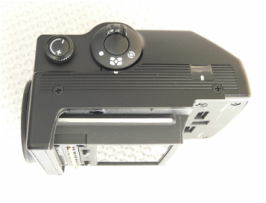 DP-20 Finder w/ 3-Mode Selector DP-20 Finder w/ 3-Mode Selector Metering - The short answer: Do you want simple (F4) or simpler (F3)? More in depth: The F4 offers 3 metering modes: 1) matrix (5-segments), 2) traditional Nikon center-weighted (60% concentrated in the 12mm dia. circle in the viewfinder w/ the remaining 40% over the rest of the screen), and 3) spot (100% concentrated in the 5mm circle in the center of the viewfinder). All three modes are available when using the standard DP-20 Finder; (2) & (3) are available with the DA-20 Action Finder; and (3) is the only option for the DW-20 Waist Level Finder & DW-21 6x High-Magnification Finder. The F3 has one metering pattern: 80/20 centerweighted. That's all, no gimmicks, just 80% of the sensitivity concentrated in the 12mm circle in the viewfinder with the remaining 20% rapidly falling off before it reaches the edge of the screen. And it is usable with all 8 finders for the F3. It is not your average centerweighted meter, nor is it a true spotmeter. So it takes a little adjustment, but if you play around with it a bit to get to know its tendencies you'll find it very consistent and simple to use and compensate for. The F3 meter slots quite neatly in between options (2) & (3) on the F4. It will be fooled less often than the 60/40 pattern in the F4, so it may be the best of both worlds. If you plan to use a variety of finders, you may also find the F3's 80/20 less finicky than the F4's spot setting. Once you are familiar with either one, the results will be there. Speaking of finders, let's compare them now. 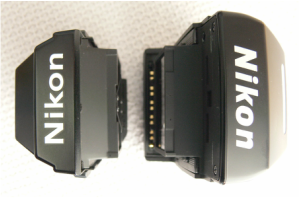 Standard Finders for F3 (DE-2) & F4 (DP-20) Standard Finders for F3 (DE-2) & F4 (DP-20) Finders - The short answer: We'll just go straight to details :-) In-depth: The F3 was eventually available with 8 finders: DE-2 Eye-Level (original w/ about 20mm eye relief); DE-3 High Eye Point (25mm eye-relief & most common); DE-4 (titanium version of the DE-3, only with titanium F3/T bodies); DE-5 w/ non-TTL ISO hot shoe, only with F3P (Press) bodies; DA-2 Action (double the height of the DE-3 with 65mm of eye-relief); DW-3 Waist Level; DW-4 6x Magnification; and finally the DX-1 (Auto Focus, only available with the F3AF body w/ focusing screen built-in). When originally released in 1980 the F3's DE-2 finder sported the same specifications as the previous F-series standard finders: 0.8x magnification with 100% coverage. In March of 1982, the DE-3 was released, and soon became the most popular finder for the F3. In exchange for longer eye relief, particularly beneficial for eye-glass wearers, the magnification dropped to 0.75x and bulk increased a bit and weight also did by 60 grams (1.5 oz.). The F3HP was so successful for Nikon that when they developed the F4, the standard DP-20 finder was a high eyepoint design with 22mm of eye relief and 0.7x magnification. The F4's lineup was rounded out with updated Action (DA-20), Waist Level (DW-20), and 6x High magnification (DW-21) finders. DE-2 fitted F3s are the best bargains if you don't need the extra eye-relief of the DE-3. Aside from the mounting system differences talked about earlier, the biggest difference between the two systems are the viewfinder displays. The F3 is, unsurprisingly, more spartan in appearance, with only an ADR (aperture direct readout) window and a small LCD that displays shutter speed and +/- over & under exposure symbols in the top left corner of the viewfinder. If you like a simple, uncluttered viewfinder, the F3 is definitely the ticket. The F4 packs a lot more information in there. On the top left of the ADR window is exposure compensation value and the frame counter. To the right are the focus indicators for the electronic rangefinder and auto focus. On the far right are a red exposure compensation warning lamp and flash ready signal. Across the bottom from left to right are: metering mode, shutter speed, AE lock indicator, and electronic analog display for Manual mode from +2 to -2 EV in 1/3 -steps. So it comes down to how much information you want in the viewfinder. The one area that the F4 clearly outstrips the F3 viewfinder is in illumination: there is a convenient lever under the shutter speed dial that activates nice even green illumination behind the LCD & ADR displays; on the F3 there is a fiddly little red button wedged on the side of the finder that is very difficult to activate and the illumination is rather pathetic. Something to bear in mind if you do a lot of low-light photography. One thing that applies to both cameras that you want to carefully check out is the condition of the LCD displays. Nikon's original estimate of a 6 to 7 year lifespan for these LCDs was, fortunately, very conservative. Nevertheless, there are issues to be aware of: LCD bleed (patches of black that prevent the readout from being seen), and fading (self-explanatory ;-)). Fortunately, a toasted LCD will not render either camera inoperable, but be aware that this problem can appear at anytime. With the F4, if the bottom (as you look through the viewfinder) LCD goes, it can be remedied by replacing the finder and you can still find DP-20s for half-decent prices at this point. For the top LCDs in both models, no such joy, as Nikon no longer supports service for the body-mounted LCD panels. You are left with cannibalizing parts from another body. Manual Focusing - The short answer: Six of one, a half-dozen of the other In-depth: Both cameras have a wide variety of interchangeable focusing screens for virtually any application. In 1985, Nikon introduced their Brite View screen technology (with the F-301/N2000 SLR) to make focusing easier with the smaller-apertured (f/3.5 - 4 and up) zooms that were replacing primes as standard lenses. All F4 screens are of the Brite View type. Brite View improved the diffusion of light passing through the screen, brightening the overall view (thus the name ;-)) compared with previous versions, but specifically lessening blackout of the split-image rangefinder (when included with a particular screen), with no blackout up to f/4.5 (most older split-image rangefinders started blacking out above f/2.8) and remaining usable up to f/8. The older screens used a finer-grain matte field, which made for a darker viewfinder but easier focusing (for many, but not all, people) with apertures wider than f/2.8. Your eyesight will have an impact on which type of screens you prefer; some people find the darker but more grainy screens easier to use, while for others a brighter view helps them more. F3 screens did not come with Brite View, but they did become somewhat brighter with the introduction of the "Red Dot" series (a red dot was added to at the far right of the engraving specifying the type of screen on the side of the frame). Your lens choices (faster primes vs. zooms with apertures f/3.5 and higher) will impact which focusing screens you choose to use with an F3. The F3 had 5 options with split-image rangefinders (one of which, the "R" screen, was designed to offer easier focusing with f/3.5-and-darker lenses) to the F4's two (AF was having an impact here) . Also, the F3 features a series of 4 H-type screens that have 100% microprism coverage and must be matched to particular focal length lenses for very low-light work. These screens were not carried over for the F4. F3 and F4 screens are not interchangeable, although they can be physically installed in either body. Doing so will result in focus errors. Costs for the more common replacement screens are creeping up for the F3 while F4 screens are a bit less, but with some of the rarer screens for either camera getting very pricey. Lens Compatibility - The short answer: F4 More in-depth: The F4 has the greatest level of F-mount lens compatibility of any Nikon body, ever, full stop. Turn out the lights when you leave ;-). Ok, but that doesn't mean you'll be scrounging for glass for an F3, which can use pretty much any F-mount Nikkor with an aperture ring, although mounting an AF lens on one probably throws the universe out of whack :-). There are 8 specific MF Nikkor lenses that cannot be used on an F4: all 8mm f/8; 16mm f/3.5 (Serial#s 272281-290000); 28mm f/3.5 (625611-999999; 35mm f/1.4 (385001-400000); all 55mm f/1.2; all old-type reflex 1000mm f/6.3; all 21mm f/4; all old-type PC 35mm f/3.5. Also, the AF teleconverter TC-16 for the F3AF cannot be mounted on an F4. The new E-type AF Nikkors are not usable on either camera, and G-type (no aperture ring) AF Nikkors can only be used in Shutter-priority or Program on the F4. Both models have the flip-up AI (Automatic Aperture Indexing) tab, allowing the use of non-AI (Pre-1977) Nikkors with stop-down metering. ***NOTE*** S-mount (rangefinder) Nikkors are not compatible with F-mount SLRs and will not mount without at least jamming and possibly damaging an F-mount camera. Ergonomics - The short answer: only YOU can determine what fits you best! More in-depth: Nikon's ergonomics had improved slowly since the original F, but larger leaps forward began with the F3, when Guigiaro Giorgetto was hired to do its exterior design. The F3 began to gain some organic curves which only intensified with the F4. That is not to say that the ergonomics of the F4 are necessarily better for you or me. People with smaller hands can find the F4's MB-20 grip too bulky (the MB-21 is a bit skinnier), while others find that they can't grip a bare F3 as securely as they would like without excessive fatigue. The point is, try each one out before deciding. We often get hung up too much on specs and the numbers game and forget that the interface between photographer and camera is more important. Especially with these cameras is that true. Very few of us are interested in these cameras for ultimate cutting-edge performance (although the F4 can give modern bodies a run for their money in many ways). We are in it for the feel of using a well-engineered and built machine that inspires us to take and make photographs. 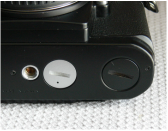 Buying & Usage Tips For the F3:
For the F4:
For both cameras:
Summary At the outset the question was posed "What are your priorities?". Hopefully, this article has helped you to define your priorities clearly and get an idea about which of these two classics may be for you. The F3 certainly has less overall technical capability than the F4, but it offers plenty enough capability for many of us. With the benefits of far less weight in bare bones, manual-winding form, and an uncluttered viewfinder. In one word: simplicity. However, if you are looking for the ultimate in compatibility with more of the Nikon system than any other body, both manual and auto focus, the F4 is unparalleled. While the AF performance of the F4 is not cutting-edge, as befits a camera born in the infancy of that technology, it is definitely usable today if needed. However, the F4's manual focus capabilities are unmatched by any AF SLR produced before or since. Newer SLRs and DSLRs (aside from Nikon's Df) have sacrificed manual focus capability, especially with fast lenses, for focusing screens optimized for the smaller maximum apertures of zoom lenses. As of mid-2020, F4 values are sitting between $200 - $250 USD for excellent to near-mint examples while F3s are running $50 - $100 USD more for copies in equivalent condition, making price point more of a difference than when this article was originally written. With some patience you can dig up an excellent F3 for $300 USD. There is no wrong choice. There is only a better choice for YOU. Both of these cameras have a plethora of accessories available, sometimes fairly inexpensively, to customize them to your photographic needs. They are both gorgeous examples of Nikon engineering at its best. And Giugiaro's styling wasn't too shabby, either :-). Enjoy! References: Nikon F4 User Manual @ http://cdn-10.nikon-cdn.com/pdf/manuals/archive/F4- F4S.pdf Nikon F3 User Manual @ http://cdn-10.nikon-cdn.com/pdf/manuals/archive/F3.pdf Nikon F3 @ http://www.mir.com.my/rb/photography/photography.htm Nikon F4 @ http://www.mir.com.my/rb/photography/photography.htm Debut of Nikon F3 @ http://imaging.nikon.com/history/chronicle/history-f3/ Debut of Nikon F4 @ http://imaging.nikon.com/history/chronicle/history- f4/index.htm
17 Comments
Vincent
12/12/2018 08:58:45 am
Top quality review, just what I was looking to obsorb. A technical review with no bias towards either or.
Reply
C.J. Odenbach
12/12/2018 10:05:42 am
I am glad to hear that you found this article to be helpful, Vincent, and for taking the time to comment.
Reply
Jeff
5/1/2019 11:23:18 am
I had read your article, Thanks for your sharing. Why all 55mm f/1.2 cannot be used in F4 body?
Reply
C.J. Odenbach
5/1/2019 12:20:41 pm
Hi Jeff,
Reply
Jeff
5/2/2019 03:45:37 am
Thanks for the answer, I am making a decision on buying a Nikon film camera, F4 was my first pick but now it seems that is not suitable for me and I am still considering the Fm2 or F3, anyways thanks a lot!
Vincent
7/25/2019 01:14:41 am
Excellent review!
Reply
C.J. Odenbach
7/25/2019 11:23:08 am
Thank you for sharing your experience, Vincent. It serves to emphasize the importance of analyzing one’s personal circumstances and giving more weight to that than just getting something because it’s great for someone else, when choosing cameras or any other accessories, for that matter. Different strokes for different folks :-).
Reply
Ben
12/9/2019 08:40:43 pm
Thanks for the review!
Reply
C.J. Odenbach
12/9/2019 09:27:48 pm
Hi Ben,
Reply
Matthew Phelim Doran
5/13/2020 01:25:51 pm
First class review and excellent discussion.
Reply
C.J. Odenbach
5/13/2020 02:22:19 pm
Thank you, Matthew. Glad you enjoyed the article.
Reply
Richard
4/9/2021 10:33:15 am
Great review, thank you. One of my first jobs was working in a camera store in the early 90s. I remember holding an F4 for the first time and being blown away by it. It seemed so out of reach back then. Now I have the means to pick up some of those pro toys from that era I’m going to make my decision on the back of this great article.
Reply
C.J. Odenbach
4/9/2021 11:34:55 am
Glad you enjoyed the article, Richard. They certainly are more accessible now than 30 years ago :-).
Reply
Geoff
9/28/2021 10:52:29 am
Just found your site and found your brilliant and comprehensive review. I am currently waiting for a F3 HP to arrive (can’t wait) but now wondering if the standard F3 with standard finder would better as this has higher magnification. Is there much difference in practical terms. Many thanks.
Reply
C.J. Odenbach
9/28/2021 11:40:08 am
Glad you enjoyed the article and congratulations on your acquisition of an F3HP, Geoff. I wouldn't sweat the 0.05x difference in magnification between it and the plain F3. More magnification does tend to aid in hitting focus, but there were probably 4 HPs sold for every standard F3 overall (and it was probably more like 9 out of 10 after the HP debuted in 1982) so the difference between the two is negligible when it comes to ease of focusing. If you wear eyeglasses or might in the future, the greater eye relief of the HP will be much more valuable than a small bump in magnification. The desirability, for most users, of the HP is reflected in the higher prices it generally commands in spite of the greater relative rarity of the plain F3 and its 60-gram weight savings. Best regards.
Reply
3/2/2024 09:56:05 am
Hello C J !
Reply
C.J. Odenbach
3/2/2024 10:38:36 am
Hello Vedran. Thanks for reaching out. The corrosion should have no effect on scratching the film as it contacts it outside the image area. Best regards.
Reply
Your comment will be posted after it is approved.
Leave a Reply. |
C.J. OdenbachSuffers from a quarter-century and counting film and manual focus SLR addiction. Has recently expanded into 1980's AF point and shoots, and (gack!) '90s SLRs. He even mixes in some digital. Definitely a sick man. Categories
All
Archives
June 2024
|
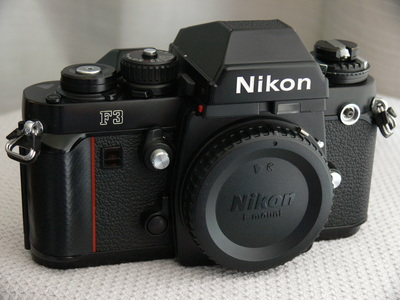
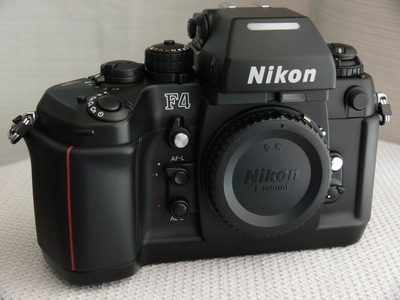
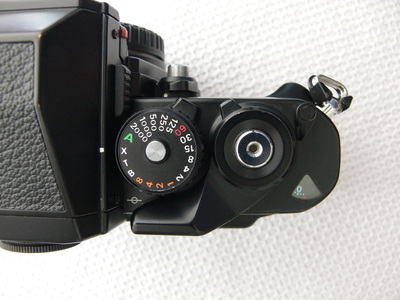
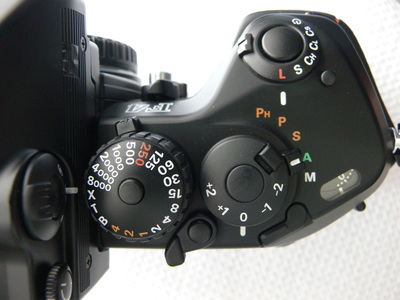
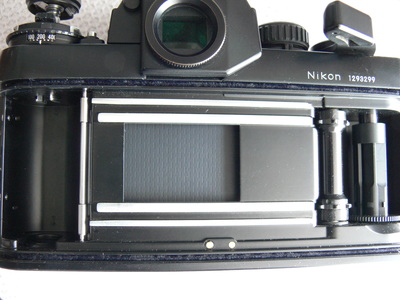
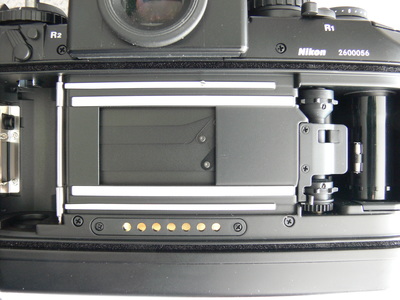
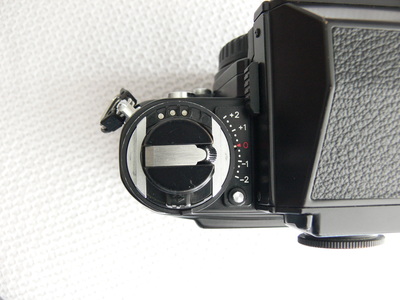
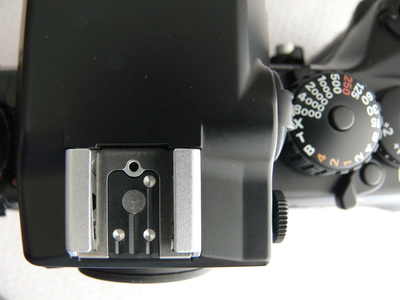
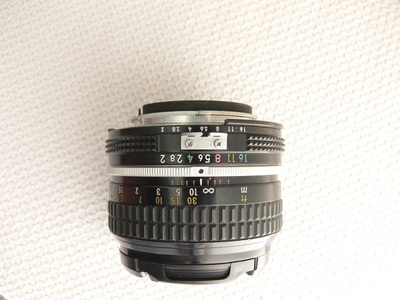
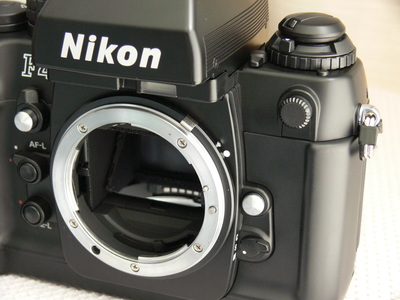
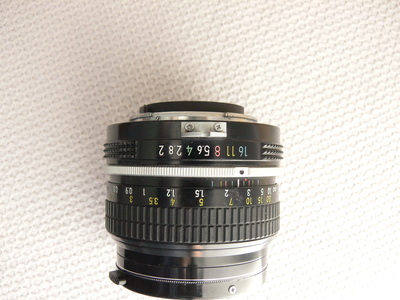
 RSS Feed
RSS Feed